Volume 1, Number 1, 1994
Speaker Primer
Revised July, 2003
Speakers represent one of the most important choices you can make as to the final sound that you will be hearing in your home entertainment room. They also have a very wide price range, and can be purchased for less than $100 per pair, and up to more than $70,000 per pair. You might ask the question, "what the heck is inside there to make them so expensive?" The answer is similar to why some amplifiers cost so much. The more expensive speakers are generally made in very small quantities, with custom built speaker drivers (see below), and fine cabinet work. In general, you get what you pay for, but the tonal characteristics of each speaker system differ, perhaps more than any other component in a sound system. Thus, it is imperative that you listen to a large number of speakers to find the ones that sound best to your ears. Some will have a bright sound, others a strong midrange, and others a very deep bass. Although some are more neutral (tonally correct) than others, no speaker reproduces the audio spectrum (the human range of hearing) perfectly. They all "color" the sound to varying degrees, regardless of price. This coloration is something built in, depending on the preferences of the designer. Finding speakers that satisfy your preferences takes some time and effort. Speaker Driver Design Speakers consist of one or more driver units in a box. The driver is constructed of a metal frame to which is attached a cone, made of paper or plastic and occasionally metal. At the rear end of the cone is attached a coil of wire (the "voice coil") wound around an extension of the cone, called a "former". The two ends of the voice coil are connected to the crossover network, and the crossover network is connected to the speaker binding posts on the rear of the speaker enclosure. The voice coil is suspended inside a permanent magnet so that it lies in a narrow gap between the magnet pole pieces and the front plate. The voice coil is kept centered by a "spider" that is attached to the frame and to the voice coil. In some speakers, a rear vent allows air to get into the back of the driver when the cone is moving, but a dust cap on the cone keeps air from getting in through the front. In others, the dust cap is the vent, made of a permeable material such as cloth. A rubber, foam, or sometimes cloth surround at the outer edge of the cone allows for flexible movement. In the case of a tweeter, the cone is very light, perhaps made of silk or a thin sheet of metal, and is glued directly to the voice coil and the frame, forming both the diaphragm and suspension. Most tweeters don't move enough air per cycle to require a vent, though some are mounted with damped chambers, or open transmission lines which "vent" the rear wave to reduce acoustic resonance behind the tweeter for smoother response. When the musical electrical signal from the amplifier passes thro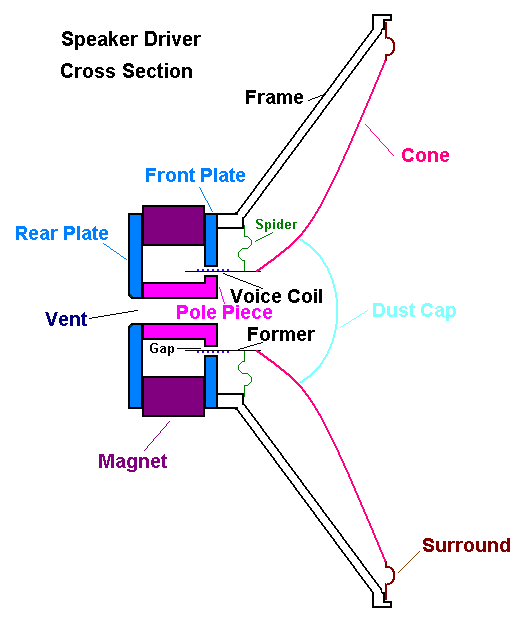 ugh
the voice coil, the voice coil turns into an electromagnet. Depending on
which way the current is traveling in the voice coil, the north and south
pole of the magnetic field will be at one end of the voice coil or the
other. The permanent magnet has a north and south pole as well. Its magnetic
field will push the coil (and the attached speaker cone) outward if the
north and south poles of the two magnetic fields are lined up together
(north to north, and south to south), or pull the voice coil inward if they
are lined up oppositely (north to south, and south to north).
So, as the electrical signal from the amplifier, which
is a representation of the original musical waveform, passes through the
voice coil, and changes direction with the musical waveform, the voice coil
and attached speaker cone are driven outward and pulled inward with the
music. The speaker cone pushes or pulls air in the room, which translates to
increases or decreases in air pressure at your eardrums, and there you have
it: music.
A speaker with just one type of driver is called a "one
way". If it has two drivers, such as a "tweeter" to handle high frequencies
and a "woofer" to handle the mid and low frequencies, then it is called a
"two way". Separate high frequency drivers (tweeters), midrange drivers, and
low frequency drivers (woofers) are found in "three way" speakers. You might
find a one way speaker in a pocket radio, but home theater and hi-fi
speakers are generally two way or three way in design.
Speaker Enclosures
The various combinations of drivers are placed in boxes
(enclosures or cabinets) of two basic configurations being the most common.
The sealed box is the simplest configuration, in which the
woofer is simply mounted in a box with no other openings. This provides two
functions. First, it keeps the output from the back of the driver, which is
out of phase from the output of the front of the driver, from the outside of
the box, so that the bass doesn't cancel out. Secondly, it provides some
additional stiffness for the suspension of the driver, as the internal air
acts as a spring when the driver moves back and forth, changing the internal
air pressure. Enclosures which provide more stiffness from the internal air
than the driver's own suspension are called "acoustic suspension." These are
typically small sealed boxes. Enclosures that contribute less stiffness
through the internal air pressure than the driver's own mechanical
suspension are referred to as "infinite baffle," and are usually on the
large side. Most commercially available sealed box designs available today
are acoustic suspension, primarily due to the smaller enclosure size.
The second configuration, which is quite common in most mass
market products, as well as some high-performance products, is the
bass-reflex design. While a sealed box is a single resonant system, a
bass-reflex system is two resonant systems, the active driver, and the
reflex system. The reflex system works by sucking acoustic output from the
rear of the active driver, and then rebounding that energy back out of the
cabinet, either through a "port" (a tube) or a passive radiator (has
the frame and cone but no voice coil or magnet). These systems can generally deliver more bass
extension in terms of their -3 dB cutoff limit everything else being equal,
but they also have their drawbacks. The output from the port or passive
radiator becomes greatest at the system's tuned frequency, determined by the
port dimensions, passive radiators dimensions and weight, and the enclosure
volume.
Above the tuned frequency, the port contributes relatively little to
the total output, moving more or less in phase with the active driver. As
the frequency reproduced moves down to the tuned frequency, the reflex
system starts to dominate the output, as it's sucking energy so efficiently
from the active driver that while the active driver barely moves, the output
from the port or passive radiator may be tremendous. Below the tuned
frequency, the output of the port or passive radiator becomes more and more
out of phase with the active driver, and more and more equal, so that at
lower frequencies, while the driver and the port may be huffing away, it
results in very little real SPL, resulting in a much sharper decline in
response (24 dB/octave) below the low-frequency cut off than a sealed box
(12 dB/octave.) In other words, a bass reflex system can improve bass
extension and output to a point, after which it makes it worse. The
difference between a port and a passive radiator in terms of performance,
generally speaking, are that a port doesn't have any output limitations
relating to limited air volume, compared to a passive radiator with a fixed
displacement limit. On the other hand, a passive radiator cannot suffer from
turbulence noise which afflicts many ported designs.
A variation used in some cases is called "push pull", uses
two active (electrically connected to the amplifier) drivers for the pushing
and pulling. One driver is mounted inside the non vented box facing outward,
and another is mounted outside, facing inward, with the two drivers
electrically connected out of phase so that when the cone of one is being
driven outward, away from the magnet, the other is being pulled inward,
towards the magnet, both being actively driven by the amplifier. Because
they're electrically out of phase, AND mechanically out of phase, they're
acoustically in-phase. The primary benefit of this arrangement is that even
ordered harmonic distortion from each driver is acoustically out of phase,
due to the inverted mechanical orientation, and so cancels out, resulting in
lower distortion. A secondary benefit, due to the presence of a second
driver working in tandem, is an increase in efficiency of roughly 3 dB,
assuming the drivers are fairly close to each other, so that two drivers
have the potential for four times the output of a single driver. "Push-pull"
arrangements can be used with either sealed or bass-reflex designs.
Another trick is to use a "compound pressure" system,
sometimes called "isobaric." In essence, this stacks two drivers front to
front <>, back to back ><, or back to front >>, essentially using two
loudspeakers to operate as one. The outside driver radiates sound, the
inside driver pushes on the internal air, and both are coupled to each other
with the air between them. The benefits of this are primarily that you can
use an internal enclosure of half the size required for a single driver,
though the cost is that the efficiency drops to half as well. This is
because the two drivers are essentially operating as one, but using just as
much power individually. Twice the moving mass, twice the suspension, twice
the motor capacity, same surface area and displacement. Bottom line, two
drivers, half the box, same output capability, twice the power requirement
for the same SPL. However, if the driver are face to face or back to back,
and therefore wired out of phase to work at all, the resulting arrangement
will be pretty much the same as a push-pull situation in terms of reducing
even-order distortion.
Sometimes loudspeaker designs will incorporate a "servo"
system, which provides feedback and correction to a driver to lower
distortion and assure flat frequency response, much in the same way many
amplifier circuits incorporate negative feedback circuits to correct their
output by comparing it to their input. Typically, an accelerometer will sit
on the voice coil of such a woofer, measure the net force applied to the
speaker, which results in motion, subtract the difference from what it's
"supposed" to be doing compared to the input signal, invert the difference,
and then apply it back to the input signal to offset the error. It does this
continually, fairly quickly, so that there isn't much in terms of lag,
particularly in the case of subwoofers. Because the accelerometer measures
the output of the driver directly, this technique will only work with sealed
systems.
The direction that the speakers radiate their sound depends
on how the drivers are lined up in the enclosure. If the speaker has all
drivers in the front, and radiates sound primarily forward, it is called a
"direct radiating" speaker. If there are some drivers on the back, and those
drivers are in phase with the front drivers, it is called a "bipolar"
radiator. If there is substantial output from the rear of the speaker, and
it is out of phase with the output from the front of the speaker, either due
to out of phase drivers, or simply because the output is from the rear of
the same speaker of the front, such as the case if Ribbon or Electrostatic
panels, it is a "dipolar" radiator.
ugh
the voice coil, the voice coil turns into an electromagnet. Depending on
which way the current is traveling in the voice coil, the north and south
pole of the magnetic field will be at one end of the voice coil or the
other. The permanent magnet has a north and south pole as well. Its magnetic
field will push the coil (and the attached speaker cone) outward if the
north and south poles of the two magnetic fields are lined up together
(north to north, and south to south), or pull the voice coil inward if they
are lined up oppositely (north to south, and south to north).
So, as the electrical signal from the amplifier, which
is a representation of the original musical waveform, passes through the
voice coil, and changes direction with the musical waveform, the voice coil
and attached speaker cone are driven outward and pulled inward with the
music. The speaker cone pushes or pulls air in the room, which translates to
increases or decreases in air pressure at your eardrums, and there you have
it: music.
A speaker with just one type of driver is called a "one
way". If it has two drivers, such as a "tweeter" to handle high frequencies
and a "woofer" to handle the mid and low frequencies, then it is called a
"two way". Separate high frequency drivers (tweeters), midrange drivers, and
low frequency drivers (woofers) are found in "three way" speakers. You might
find a one way speaker in a pocket radio, but home theater and hi-fi
speakers are generally two way or three way in design.
Speaker Enclosures
The various combinations of drivers are placed in boxes
(enclosures or cabinets) of two basic configurations being the most common.
The sealed box is the simplest configuration, in which the
woofer is simply mounted in a box with no other openings. This provides two
functions. First, it keeps the output from the back of the driver, which is
out of phase from the output of the front of the driver, from the outside of
the box, so that the bass doesn't cancel out. Secondly, it provides some
additional stiffness for the suspension of the driver, as the internal air
acts as a spring when the driver moves back and forth, changing the internal
air pressure. Enclosures which provide more stiffness from the internal air
than the driver's own suspension are called "acoustic suspension." These are
typically small sealed boxes. Enclosures that contribute less stiffness
through the internal air pressure than the driver's own mechanical
suspension are referred to as "infinite baffle," and are usually on the
large side. Most commercially available sealed box designs available today
are acoustic suspension, primarily due to the smaller enclosure size.
The second configuration, which is quite common in most mass
market products, as well as some high-performance products, is the
bass-reflex design. While a sealed box is a single resonant system, a
bass-reflex system is two resonant systems, the active driver, and the
reflex system. The reflex system works by sucking acoustic output from the
rear of the active driver, and then rebounding that energy back out of the
cabinet, either through a "port" (a tube) or a passive radiator (has
the frame and cone but no voice coil or magnet). These systems can generally deliver more bass
extension in terms of their -3 dB cutoff limit everything else being equal,
but they also have their drawbacks. The output from the port or passive
radiator becomes greatest at the system's tuned frequency, determined by the
port dimensions, passive radiators dimensions and weight, and the enclosure
volume.
Above the tuned frequency, the port contributes relatively little to
the total output, moving more or less in phase with the active driver. As
the frequency reproduced moves down to the tuned frequency, the reflex
system starts to dominate the output, as it's sucking energy so efficiently
from the active driver that while the active driver barely moves, the output
from the port or passive radiator may be tremendous. Below the tuned
frequency, the output of the port or passive radiator becomes more and more
out of phase with the active driver, and more and more equal, so that at
lower frequencies, while the driver and the port may be huffing away, it
results in very little real SPL, resulting in a much sharper decline in
response (24 dB/octave) below the low-frequency cut off than a sealed box
(12 dB/octave.) In other words, a bass reflex system can improve bass
extension and output to a point, after which it makes it worse. The
difference between a port and a passive radiator in terms of performance,
generally speaking, are that a port doesn't have any output limitations
relating to limited air volume, compared to a passive radiator with a fixed
displacement limit. On the other hand, a passive radiator cannot suffer from
turbulence noise which afflicts many ported designs.
A variation used in some cases is called "push pull", uses
two active (electrically connected to the amplifier) drivers for the pushing
and pulling. One driver is mounted inside the non vented box facing outward,
and another is mounted outside, facing inward, with the two drivers
electrically connected out of phase so that when the cone of one is being
driven outward, away from the magnet, the other is being pulled inward,
towards the magnet, both being actively driven by the amplifier. Because
they're electrically out of phase, AND mechanically out of phase, they're
acoustically in-phase. The primary benefit of this arrangement is that even
ordered harmonic distortion from each driver is acoustically out of phase,
due to the inverted mechanical orientation, and so cancels out, resulting in
lower distortion. A secondary benefit, due to the presence of a second
driver working in tandem, is an increase in efficiency of roughly 3 dB,
assuming the drivers are fairly close to each other, so that two drivers
have the potential for four times the output of a single driver. "Push-pull"
arrangements can be used with either sealed or bass-reflex designs.
Another trick is to use a "compound pressure" system,
sometimes called "isobaric." In essence, this stacks two drivers front to
front <>, back to back ><, or back to front >>, essentially using two
loudspeakers to operate as one. The outside driver radiates sound, the
inside driver pushes on the internal air, and both are coupled to each other
with the air between them. The benefits of this are primarily that you can
use an internal enclosure of half the size required for a single driver,
though the cost is that the efficiency drops to half as well. This is
because the two drivers are essentially operating as one, but using just as
much power individually. Twice the moving mass, twice the suspension, twice
the motor capacity, same surface area and displacement. Bottom line, two
drivers, half the box, same output capability, twice the power requirement
for the same SPL. However, if the driver are face to face or back to back,
and therefore wired out of phase to work at all, the resulting arrangement
will be pretty much the same as a push-pull situation in terms of reducing
even-order distortion.
Sometimes loudspeaker designs will incorporate a "servo"
system, which provides feedback and correction to a driver to lower
distortion and assure flat frequency response, much in the same way many
amplifier circuits incorporate negative feedback circuits to correct their
output by comparing it to their input. Typically, an accelerometer will sit
on the voice coil of such a woofer, measure the net force applied to the
speaker, which results in motion, subtract the difference from what it's
"supposed" to be doing compared to the input signal, invert the difference,
and then apply it back to the input signal to offset the error. It does this
continually, fairly quickly, so that there isn't much in terms of lag,
particularly in the case of subwoofers. Because the accelerometer measures
the output of the driver directly, this technique will only work with sealed
systems.
The direction that the speakers radiate their sound depends
on how the drivers are lined up in the enclosure. If the speaker has all
drivers in the front, and radiates sound primarily forward, it is called a
"direct radiating" speaker. If there are some drivers on the back, and those
drivers are in phase with the front drivers, it is called a "bipolar"
radiator. If there is substantial output from the rear of the speaker, and
it is out of phase with the output from the front of the speaker, either due
to out of phase drivers, or simply because the output is from the rear of
the same speaker of the front, such as the case if Ribbon or Electrostatic
panels, it is a "dipolar" radiator.
- An animated example of how bipolar speakers work
- An animated example of how dipolar speakers work
- An animated example of how push pull speakers work
 There are a handful of special design speakers which don't
use cones. Instead, they have thin foils suspended between magnets or metal
sheets. With a ribbon speaker, the musical signal is applied to a foil
ribbon, and the
There are a handful of special design speakers which don't
use cones. Instead, they have thin foils suspended between magnets or metal
sheets. With a ribbon speaker, the musical signal is applied to a foil
ribbon, and the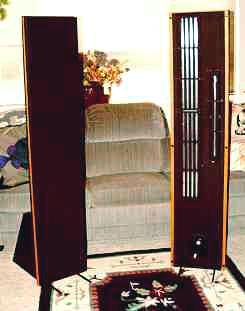 varying electrical charge placed upon it by the music causes
it to be attracted or repelled by the magnets, moving air in doing so, and
thus reproducing the sound. A variation on this consists of a foil attached
to a large flat membrane, and it is the membrane which is suspended. Such
designs are called planar-magnetic (example shown on right). Electrostatic
speakers (example shown on left), by comparison, have a plastic membrane,
coated with something like powdered graphite, suspended between two
perforated metal sheets. A positive voltage (several thousand volts) is
connected to the membrane, and the musical signal, the voltage of which is
increased by a transformer in the base of the speaker, is applied to the
perforated sheets. The varying signal in the metal sheets attracts or repels
the membrane, and the music is reproduced. These ribbon and electrostatic
speakers reproduce midrange and upper frequencies with superb clarity, but
are not very good at the low frequencies (below 100Hz) because of the lack
of an enclosure to prevent the rear waves from canceling the front waves
where the sound gets omni directional. Exceptions are VERY LARGE panels,
where the diaphragm itself provides a baffle to separate the front and rear
bass waves. Therefore, they usually have standard cone type speakers in a
separate cabinet at the base (see photos) to serve as woofers, using a
hybrid design. Ribbon speakers, planar magnetic speakers, and electrostatic
speakers are dipolar in nature.
Crossover Networks
Inside the speaker cabinet is an additional component,
called the "crossover network". This is made of one or more resistors,
capacitors, and inductors (see schematic diagram of a typical circuit on the
right). The property of a capacitor is to pass high frequencies, but to
impede low frequencies, while inductors pass low frequencies and impede high
frequencies. Resistors are used to balance the loudness between the various
drivers. The components are wired so that only high frequencies are sent to
the tweeter, midrange frequencies sent to the midrange driver, and low
frequencies to the woofer (in the case of a three way design). The crossover
network, named for the fact that it crosses over frequencies to the proper
driver, has connections to the binding posts on the rear of the speaker, so
that the signal passes through the crossover network, and then to the
speaker drivers. The property of sending low frequencies to the woofer is
called "low pass", and the property of sending high frequencies to the
tweeter is called "high pass". You may see these terms used, for example, in
setting the low pass frequency that a subwoofer crosses over at, sending all
signals below this frequency to the subwoofer amplifier, and the high pass
frequency, above which, signals are sent back to the main speakers.
varying electrical charge placed upon it by the music causes
it to be attracted or repelled by the magnets, moving air in doing so, and
thus reproducing the sound. A variation on this consists of a foil attached
to a large flat membrane, and it is the membrane which is suspended. Such
designs are called planar-magnetic (example shown on right). Electrostatic
speakers (example shown on left), by comparison, have a plastic membrane,
coated with something like powdered graphite, suspended between two
perforated metal sheets. A positive voltage (several thousand volts) is
connected to the membrane, and the musical signal, the voltage of which is
increased by a transformer in the base of the speaker, is applied to the
perforated sheets. The varying signal in the metal sheets attracts or repels
the membrane, and the music is reproduced. These ribbon and electrostatic
speakers reproduce midrange and upper frequencies with superb clarity, but
are not very good at the low frequencies (below 100Hz) because of the lack
of an enclosure to prevent the rear waves from canceling the front waves
where the sound gets omni directional. Exceptions are VERY LARGE panels,
where the diaphragm itself provides a baffle to separate the front and rear
bass waves. Therefore, they usually have standard cone type speakers in a
separate cabinet at the base (see photos) to serve as woofers, using a
hybrid design. Ribbon speakers, planar magnetic speakers, and electrostatic
speakers are dipolar in nature.
Crossover Networks
Inside the speaker cabinet is an additional component,
called the "crossover network". This is made of one or more resistors,
capacitors, and inductors (see schematic diagram of a typical circuit on the
right). The property of a capacitor is to pass high frequencies, but to
impede low frequencies, while inductors pass low frequencies and impede high
frequencies. Resistors are used to balance the loudness between the various
drivers. The components are wired so that only high frequencies are sent to
the tweeter, midrange frequencies sent to the midrange driver, and low
frequencies to the woofer (in the case of a three way design). The crossover
network, named for the fact that it crosses over frequencies to the proper
driver, has connections to the binding posts on the rear of the speaker, so
that the signal passes through the crossover network, and then to the
speaker drivers. The property of sending low frequencies to the woofer is
called "low pass", and the property of sending high frequencies to the
tweeter is called "high pass". You may see these terms used, for example, in
setting the low pass frequency that a subwoofer crosses over at, sending all
signals below this frequency to the subwoofer amplifier, and the high pass
frequency, above which, signals are sent back to the main speakers.
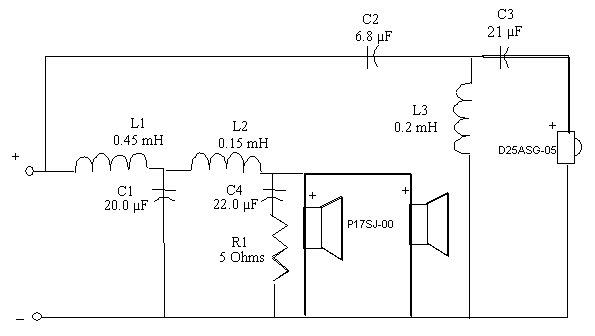
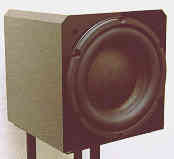
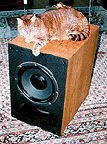 who need an
inconspicuous, yet powerful subwoofer, there are several designs with small
enclosures, but very long throw drivers and large amplifiers to compensate,
like the one shown on the right, which has a 10" driver.
The example on the
left is a 12" push-pull subwoofer. Depending on which type of subwoofer you
choose, and you decide on one of the power amplifiers that has several
channels of amplification (3 - 6) all in one chassis, you will need to
consider how many amplifier channels to purchase. If you are not going to
use the center channel (in which case, you are using the "phantom" mode),
and the subwoofer is self powered, then you only need a four channel power
amplifier. If you use the center channel and a self powered subwoofer, then
you need a five channel power amplifier, and if you use the center channel
and a subwoofer that has no amplifier of its own, then a six channel power
amplifier is in order. Remember to make your choices up front. The majority
of commercial subwoofers are self powered. Most "Digital" surround receivers
have enough amplifiers for all channels except the subwoofer.
Interestingly, subjectively higher volume will be heard from higher
distortion subwoofers at a given SPL because the harmonic distortion is
higher in frequency than the ultra-low fundamentals, and therefore more
audible. However, this distortion is not as irritating at low frequencies as
it is at higher frequencies, so, if you want a subwoofer with additional
"punch", you might consider a subwoofer with lots of distortion. As always,
listen and compare.
Auditioning Speakers
When auditioning speakers, listen primarily for detail
without artificial accents. An extra zing and zap may get one's attention on
first listen, but it can also get really irritating after many listening
hours. It's very difficult to compare speakers from store to store packed
into the demonstration rooms with each other, so reserve the option to
return your final choices, or arrange for an in-home audition for your final
contestants. As a quick qualifier, rap your knuckles on the speaker cabinet.
If it sounds like you are
who need an
inconspicuous, yet powerful subwoofer, there are several designs with small
enclosures, but very long throw drivers and large amplifiers to compensate,
like the one shown on the right, which has a 10" driver.
The example on the
left is a 12" push-pull subwoofer. Depending on which type of subwoofer you
choose, and you decide on one of the power amplifiers that has several
channels of amplification (3 - 6) all in one chassis, you will need to
consider how many amplifier channels to purchase. If you are not going to
use the center channel (in which case, you are using the "phantom" mode),
and the subwoofer is self powered, then you only need a four channel power
amplifier. If you use the center channel and a self powered subwoofer, then
you need a five channel power amplifier, and if you use the center channel
and a subwoofer that has no amplifier of its own, then a six channel power
amplifier is in order. Remember to make your choices up front. The majority
of commercial subwoofers are self powered. Most "Digital" surround receivers
have enough amplifiers for all channels except the subwoofer.
Interestingly, subjectively higher volume will be heard from higher
distortion subwoofers at a given SPL because the harmonic distortion is
higher in frequency than the ultra-low fundamentals, and therefore more
audible. However, this distortion is not as irritating at low frequencies as
it is at higher frequencies, so, if you want a subwoofer with additional
"punch", you might consider a subwoofer with lots of distortion. As always,
listen and compare.
Auditioning Speakers
When auditioning speakers, listen primarily for detail
without artificial accents. An extra zing and zap may get one's attention on
first listen, but it can also get really irritating after many listening
hours. It's very difficult to compare speakers from store to store packed
into the demonstration rooms with each other, so reserve the option to
return your final choices, or arrange for an in-home audition for your final
contestants. As a quick qualifier, rap your knuckles on the speaker cabinet.
If it sounds like you are 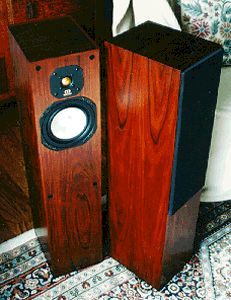 rapping against a piece of granite, this means the
cabinet is well damped from vibrating on its own, and will suffer less from
coloration due to cabinet resonance. If rapping your knuckles against the
cabinet results in a drum-like sound, the cabinet may not be well damped,
and could very well obscure sonic detail in the midrange and mid-bass areas.
A good cabinet isn't a guarantee of good performance, but it's a start.
Click here to listen to a wav file that was recorded when rapping on a
speaker that has excellent damping (the speakers shown on the left).
Most speakers have a vinyl finish (usually black) with a
wood grained appearance. Some of these look like real wood, and it is
difficult to tell that it is vinyl. If you want real wood veneers, many
designs offer this as an option. Exotic woods add several hundred dollars to
the final cost. Keep in mind that that's money not directly contributing to
real performance, even though it may very well make a customer happier with
their purchase. The speakers on the left have a rosewood veneer that is
exquisite. Other beautiful and unusual woods include jarrah and bubinga.
Move around the room during the speaker demonstration.
Listen for how the sound changes as you move side to side, or from a sitting
to a standing position. Ambience will be difficult to test in the dealer's
demonstration room, since your own room at home will be much different.
However, a certain degree of ambience can be heard with different surround
systems, such as direct, bipole, and dipole. Careful listening pays off
here. You should take a more than a few of your favorite CDs with you to
audition equipment. Include music with a wide variety of instruments and
dynamics (loudness variations) such as an orchestral symphony, as well as
sharp transient sounds (like steel string guitar), piano music, and solo
singing voices (especially female). Several brands carry models specifically
made for home theater. Keep in mind that it's difficult to tell what's the
recording, and what's the speaker, without some reference.
At low volume, even the least expensive speakers can sound
very good. Be sure to audition the speakers at the maximum volume you would
be listening to them at home. At some loudness point, every speaker begins
to produce significant amounts of harmonic distortion. A fundamental sin
wave in the low midrange, such as 500 Hz, can have many harmonics that are
audible,
rapping against a piece of granite, this means the
cabinet is well damped from vibrating on its own, and will suffer less from
coloration due to cabinet resonance. If rapping your knuckles against the
cabinet results in a drum-like sound, the cabinet may not be well damped,
and could very well obscure sonic detail in the midrange and mid-bass areas.
A good cabinet isn't a guarantee of good performance, but it's a start.
Click here to listen to a wav file that was recorded when rapping on a
speaker that has excellent damping (the speakers shown on the left).
Most speakers have a vinyl finish (usually black) with a
wood grained appearance. Some of these look like real wood, and it is
difficult to tell that it is vinyl. If you want real wood veneers, many
designs offer this as an option. Exotic woods add several hundred dollars to
the final cost. Keep in mind that that's money not directly contributing to
real performance, even though it may very well make a customer happier with
their purchase. The speakers on the left have a rosewood veneer that is
exquisite. Other beautiful and unusual woods include jarrah and bubinga.
Move around the room during the speaker demonstration.
Listen for how the sound changes as you move side to side, or from a sitting
to a standing position. Ambience will be difficult to test in the dealer's
demonstration room, since your own room at home will be much different.
However, a certain degree of ambience can be heard with different surround
systems, such as direct, bipole, and dipole. Careful listening pays off
here. You should take a more than a few of your favorite CDs with you to
audition equipment. Include music with a wide variety of instruments and
dynamics (loudness variations) such as an orchestral symphony, as well as
sharp transient sounds (like steel string guitar), piano music, and solo
singing voices (especially female). Several brands carry models specifically
made for home theater. Keep in mind that it's difficult to tell what's the
recording, and what's the speaker, without some reference.
At low volume, even the least expensive speakers can sound
very good. Be sure to audition the speakers at the maximum volume you would
be listening to them at home. At some loudness point, every speaker begins
to produce significant amounts of harmonic distortion. A fundamental sin
wave in the low midrange, such as 500 Hz, can have many harmonics that are
audible,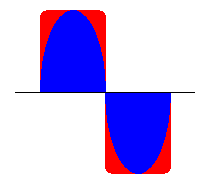 i.e., 1 kHz, 1.5 kHz, 2 kHz, 2.5 kHz, etc. This makes the sound
mushy or sometimes harsh. The diagram on the right shows a sin wave in blue.
When there is significant harmonic distortion, the waveform looks like the
outline in red (like a square wave). The red area is distortion. So, if the
speakers you are considering sound mushy at the loudest volume you like to
listen, try a different model or brand. If the speaker doesn't distort at
louder levels, it won't "sound" louder than when listening at lower levels,
it just will be.
Keep in mind that digital surround is full range in
frequency, even in the rear surround channels. So, if you purchase small,
limited range speakers, unless you have a good subwoofer, and a proper setup
in the receiver or surround processor, you're missing a lot. Also, when
using a subwoofer, be sure to calibrate it's level with an SPL meter (Radio
Shack analog model set to "C" weighting and slow response) and test tones,
usually generated by the receiver, or perhaps a test DVD, such as Ovation
Software's Avia test disc, to match the other speakers. For that matter,
make sure all speakers are calibrated in relation to each other in terms of
level and distance. Otherwise, with a subwoofer, particularly with higher
crossover points, not only will the frequency response be unnaturally bass
heavy, but the subwoofer will become easy to localize, ruining the illusion
of a solid soundscape. If the other channels levels aren't matched, you
won't hear the proportion or directional balance that the director or
recording engineer intended. A mediocre, well-calibrated system will far
outperform a "premium quality" poorly calibrated system.
i.e., 1 kHz, 1.5 kHz, 2 kHz, 2.5 kHz, etc. This makes the sound
mushy or sometimes harsh. The diagram on the right shows a sin wave in blue.
When there is significant harmonic distortion, the waveform looks like the
outline in red (like a square wave). The red area is distortion. So, if the
speakers you are considering sound mushy at the loudest volume you like to
listen, try a different model or brand. If the speaker doesn't distort at
louder levels, it won't "sound" louder than when listening at lower levels,
it just will be.
Keep in mind that digital surround is full range in
frequency, even in the rear surround channels. So, if you purchase small,
limited range speakers, unless you have a good subwoofer, and a proper setup
in the receiver or surround processor, you're missing a lot. Also, when
using a subwoofer, be sure to calibrate it's level with an SPL meter (Radio
Shack analog model set to "C" weighting and slow response) and test tones,
usually generated by the receiver, or perhaps a test DVD, such as Ovation
Software's Avia test disc, to match the other speakers. For that matter,
make sure all speakers are calibrated in relation to each other in terms of
level and distance. Otherwise, with a subwoofer, particularly with higher
crossover points, not only will the frequency response be unnaturally bass
heavy, but the subwoofer will become easy to localize, ruining the illusion
of a solid soundscape. If the other channels levels aren't matched, you
won't hear the proportion or directional balance that the director or
recording engineer intended. A mediocre, well-calibrated system will far
outperform a "premium quality" poorly calibrated system.
Related to the article above, we recommend the following: |
|

